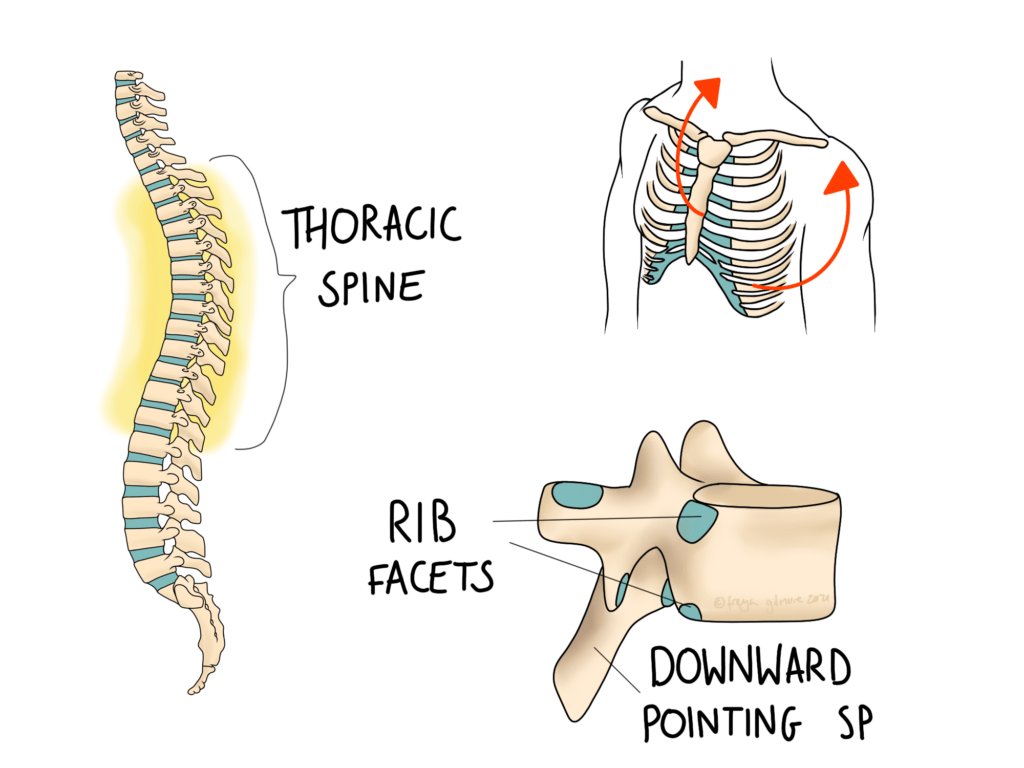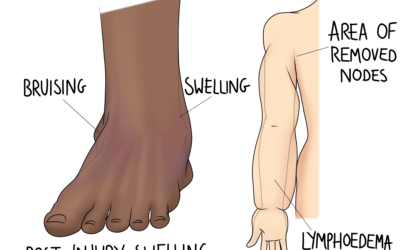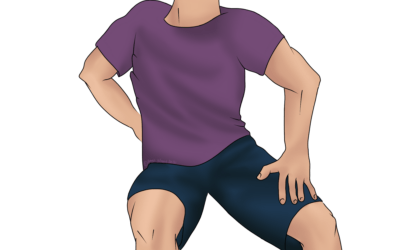Most of the time, we have very little awareness of our breathing. But have you ever noticed how your breathing changes when you’re stressed? Shorter, more shallow breaths can ask too much of the muscles around the shoulders, and lead to tension in the diaphragm.
Breathing Muscles
The primary muscle of breathing is the diaphragm. It’s a parachute-like sheet that sits at the bottom of the ribs. It lowers when it contracts, making space in the chest for the lungs to expand. When it relaxes, we exhale. You can read more about diaphragmatic breathing here.

Other muscles are involved too- the accessory muscles of breathing. These are smaller muscles, much less capable of doing the bulk of the work that the diaphragm does. They can, however, help out comfortably for short bursts. During peak exercise they help you to breathe deeper- but of course this is only for a short period of time. If your breathing is inefficient all the time, the accessory muscles will quickly fatigue. Tension can develop around the shoulders, upper back, and neck, causing new aches and pains.
Headaches and Grinding Teeth
When the accessory muscles on the front of the neck are involved, they can cause you to let your head sit too far forwards. You might not notice this yourself, but you might feel the effects:

As the head is brought forwards, the mechanical load changes. Normally, the most efficient position for your head is one that balances the weight on bones and ligaments. But as your head comes forward, it has a levering effect and becomes “heavier”. Muscles have to work harder, and muscles that attach to the bottom of the jaw activate. The image above shows that this pulls the jaw as if to open it. But we typically keep it closed reflexively. This is achieved by the muscles around the cheek tensing. Tension on either side of the jaw is less than ideal, and may be associated with teeth grinding. This in itself can cause headaches, and can be tricky to identify if it only happens when you’re asleep. But if you catch yourself gritting or grinding your teeth in the day, make sure you mention it to your osteopath. It may also be appropriate to see your dentist- they can offer a gumshield-like “splint” for you to wear overnight if appropriate. This can protect your teeth, and for some people, it prevents their grinding in itself.
Headaches can be caused by tension at the back of the neck too. The head position described above encourages the joints at the top of the neck to extend or tip back. The muscles running over them can then shorten or tense. These muscles are often involved in cervicogenic headaches. You might find that some heat or a massage to the base of the skull gives quite immediate relief, but the headache keeps returning. Your osteopath can help with this type of headache. Make note of the nature of your symptoms:
- where you feel the pain
- the nature of the pain (burning, sharp, achey)
- how long an episode lasts
- what makes it better or worse
- how frequently they come on
- whether or not there are any other symptoms (visual or speech changes for example)
One Patient’s Experience
A patient presented to clinic with pains throughout the chest and upper back. The pain only ever focused on one point at a time, and they seemed to follow no pattern. As she explained her history, it transpired that she had had similar pains years ago, when a heart problem surfaced. This required emergency surgery, which was quite traumatic. She said that she was worried that something similar was happening again.
On examination, she was breathing “backwards”. As she breathed air in, she also sucked in her tummy, so her diaphragm could not work effectively. As she breathed out, she relaxed her tummy. This was subconscious, and a big part of her treatment plan was retraining her breathing. Interestingly, she found this easier when wearing outfits that did not include tights- the waistband was tight around her abdomen and made it harder to let her tummy move naturally. Her symptoms began to ease very quickly, and were totally gone within a few weeks.
Rib Movement While Breathing
The diagram below shows how the ribs move while we breathe. The upper ribs move like a pump handle, coming forward and up as you breathe in. In contrast, the lower ribs flare out like bucket handles. When there is tension or restriction in the muscles and joints of the thorax, this movement can be altered. As alternative breathing patterns are less efficient, this change can compound the original issues.
Anatomy of the Thorax
The thorax is the technical term for the whole chest, front and back. In terms of bones, it is made of:
- 12 vertebrae of the thoracic spine
- 12 pairs of ribs
- the sternum
- the collar bones
- (shoulder blades may be considered part of the thorax as they interact with the ribs)
The ribs limit the movement of the thoracic spine, making it a very stable area. However, it can be prone to getting very stiff, sometimes without you even noticing. Often patients with sedentary jobs, or people who do a lot of driving will present with stiffness as part of their problem. These postures can encourage rounded shoulders, putting extra pressure on the collar bones. In turn, they may become stiff where they meet the shoulder blade or sternum, causing achiness or clicking.
There are a number of clinically relevant muscles, nerves, and other tissues in the thorax that might lead you to clinic. Problems at the front of the shoulder can cause thoracic outlet syndrome. Here, nerves or blood vessels are irritated by muscles or ribs, causing pain and weakness in the arm and hand. This can be mistaken for carpal tunnel syndrome initially, so your osteopath will take a detailed case history and examine you thoroughly to be sure.
Pain in the Thoracic Spine and Beyond
Although a less common complaint than lower back pain, upper back pain is far from unusual. But the causes of symptoms are often quite different. Discs are unlikely to bulge due to differences in movement and anatomy of this area of the spine. Despite this, we often treat the thoracic spine when another area is symptomatic. The reasoning for this varies from case to case, but often it is because the thorax has a direct influence on both the neck and lower back. Bulging discs in the neck and lumbar spine are typically due to an overload at that segment. If we can keep the thoracic spine moving as well as possible, forces can dissipate more evenly throughout the spine, avoiding pinch points that could overload a disc.
Shoulder issues can also benefit from thoracic work. Throwing injuries, and other sports injuries, may have been caused in part by limitations in the upper back. Ensuring the muscles and joints of the thorax are at their optimum helps the shoulder to get on with what it needs to. Similarly, if you’ve played on through an injury like this, you might have irritated the tissues of the upper back as they compensate for a braced, painful area.
Sometimes, what looks like thoracic spine pain, might actually turn out to be a rib issue. A catching pain at either end of a rib, especially on deep breathing, might suggest that the rib is to blame. Sometimes a quick technique to manipulate the joint is sufficient to resolve this, or other times it might be a wider reaching problem. Your osteopath can assess the whole ribcage to identify the root cause of your painful rib. The last two pairs of ribs are “floating”, as they don’t attach to the front of the chest at all. They have some strong muscles attached to them, and could be irritated by tension within these muscles. For example, lower back pain associated with muscular guarding could extend into a lower rib problem. Your osteopath’s detailed examination should identify if this is the case for you.
The thoracic spine can be a key area for diagnosing more systemic issues. From idiopathic juvenile scoliosis to ankylosing spondylitis and osteoporosis, the thorax can speak volumes. We will refer on for imaging and further investigation if we suspect these conditions.
Breathing with Asthma or Cystic Fibrosis
Conditions that negatively affect efficiency of breathing can overwork those accessory muscles in the same way. Asthma attacks are strong examples of this. Fortunately, well controlled asthma does not seem to have a significant effect on the muscles. Cystic Fibrosis has a constant negative effect on the efficiency of breathing, and studies show that this particularly effects the diaphragm. Although we cannot affect the condition itself, we can help with the secondary effects on the body. Work to the diaphragm, upper back, shoulders, and neck can give some relief from associated aches and pains. Some stronger techniques will not be appropriate for patients with long term or current steroid use, but we always have alternatives that are more appropriate for these patients.
Click here to make an appointment to address your aches and pains in Leeds




0 Comments